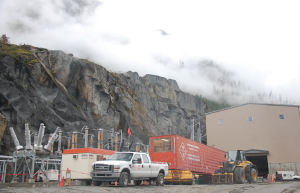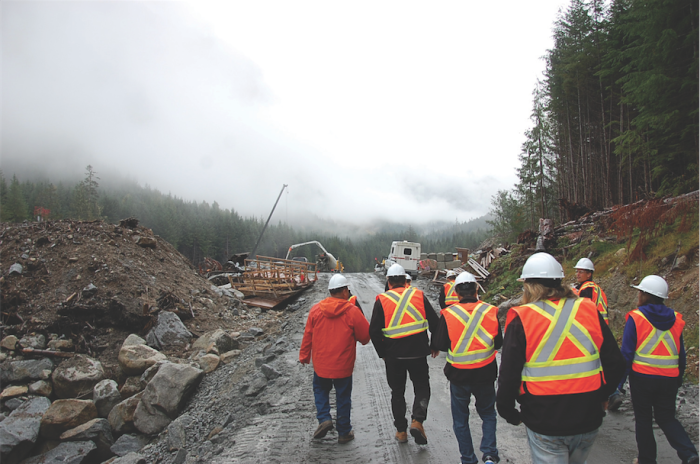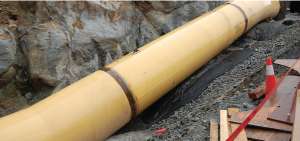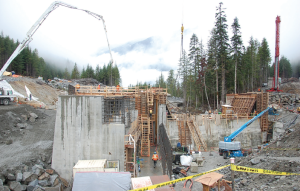What Does a Megawatt Mean to You?
Leaders of Klahoose and Sliammon nations recently travelled to Toba Inlet for an update on the Jimmie Creek run-of-river project since work began one year ago. Johnny Hanuse was there to report and take photographs.
What does a megawatt mean to you? How does another run-ofthe- river project affect your life or community?
These are some of the questions that might be asked while looking at the development of Jimmie Creek in the Toba Valley. On the tour were: Chief James Delorme and council members Billy Barnes and Kevin Peacey of the Klahoose First Nation, members of the Qathen Xwegus Management Corporation, Chief Clint Williams of Tla’Amin (Sliammon) and representatives of the Alterra Power Corp.
The power of water has always been a miracle for humankind. It has sustained human life from time immemorial and has reminded us of the dangers of Mother Nature. Technology and time have brought a new respect for the energy that can be honed from its raw power.
Chief James Delorme says, “Own-source revenue from green energy projects like this and our Toba Montrose project brings Klahoose a new level of success for generations to come.” The Jimmie Creek project currently employs 43 Klahoose band members and 11 other First Nations people.
COMMUNITY
In order for a project like this to happen successfully, a great group of professionals is required to devote time, energy and ideas. Anyone that has worked in a camp like this understands that at times more than half of his or her life is spent in camp over the course of the project. These types of projects build a community.
So what does a megawatt mean to you? It means jobs, economic development, planning, mechanical and electrical engineering, support for many Klahoose business interests and much much more.
In the end, the Jimmie Creek run-of-the-river project will produce 62 megawatts of power at any given time. The energy is measured in megawatt hours (MWh) – operating for one hour at 62 MWh) of power. In one year the Jimmie Creek run-of-the-river project will produce 160,000 MWh of clean, renewable energy per year.
Click the tabs below for more information about the project.
Alterra Power already operates the fiveyear- old 235 MW Toba Montrose run-ofriver power plant under a power purchase agreement with BC Hydro until 2045. It is 40 per cent owned by Alterra and 60 per cent by the Montreal-based portfolio management firm Fiera Infrastructure.
 The Jimmie Creek expansion project is adjacent to Toba Montrose. With a projected annual production of up to 166,000 MWh, Alterra owns 51 per cent of the project. There is a BC Hydro power purchase agreement through 2055.
The Jimmie Creek expansion project is adjacent to Toba Montrose. With a projected annual production of up to 166,000 MWh, Alterra owns 51 per cent of the project. There is a BC Hydro power purchase agreement through 2055.
Two other proposed projects in the region are classed by Alterra as ‘early stage assets’. They are the 15MW Tahumming River hydro project in the Toba Valley and the Bute Inlet run-of-river project with a total capacity of more than 1,000 MW across 17 sites on three river systems.
The project begins at the intake, which is a large structure that hosts the entrance for water to flow through the penstock pipes.
 The structure itself is mostly made of concrete. However, years of work experience and research in the Toba Valley have shown that the rock tends to be relatively weak and deteriorates easily over time. Since water will be constantly flowing past and through this concrete structure, a different type of rock had to be mixed into the cement to build the intake infrastructure.
The structure itself is mostly made of concrete. However, years of work experience and research in the Toba Valley have shown that the rock tends to be relatively weak and deteriorates easily over time. Since water will be constantly flowing past and through this concrete structure, a different type of rock had to be mixed into the cement to build the intake infrastructure.
Rock was shipped up to the project site specifically for cement mixing. In order to build the intake, the water flow from Jimmie Creek had to be diverted from its natural path with a temporary dam. The contractor in charge of the dam has water pumps running 24/7 to deal with any leakage so as not to disturb or interfere with the intake construction.
Once the project is completed the temporary dam will be taken out and Jimmie Creek will flow through the penstock pipe down to the powerhouse.
The installation of pipelines has made significant progress in making its way down the Toba Valley towards the powerhouse. The penstock will run a total distance of 2.8 kilometres and will be made up of 185 different sections. The sections range from 12-18 metres in length (40-60 feet).
Water travels into the intake and through the pipelines, which for the most part are underground, and heads towards the powerhouse. At the intake, or penstock, the water is at its lowest pressure.
This means that the pipes at the intake can have thinner walls that gradually thickens as it nears the powerhouse. The steel pipes at the powerhouse are over 25mm (1 inch) thick to withstand the pressure of water flow year round. The powerhouse is where the turbines will be, producing energy from the water flow of Jimmie Creek.
Jason Sirois of Alterra Power was present for a part of the turbine construction in India. He was there for some of the pressurization testing to ensure the seals were in place and the pumps were working properly.
The turbines have been delayed in transit to Canada due to the permits needed to transport them from India and insurance policies that require them to be sent to Canada on two separate ships. Nonetheless, the turbines are on their way.
Alterra Power Corporation is the company that bought out Plutonic Power and signed impact benefit agreements with Tla’Amin, Klahoose and Homalco nations.
Those agreements set out the terms, including revenue sharing, for building hydroelectric facilities in the nations’ traditional territories.
In 2007, Tla’Amin (Sliammon) First Nation signed an impact benefit agreement (IBA) with Plutonic Power for development of the transmission line corridor from the East Toba River/Montrose Creek run-of-river hydroelectric projects.
The IBA – in recognition of the fact that the transmission line is located within Tla’Amin traditional territory – included a list of benefits including:
- Annual payments for the project’s life;
- Employment and training opportunities;
- Opportunities for Sliammon-owned companies in construction and operations,
In exchange, Tla’Amin gave full support for the project.







